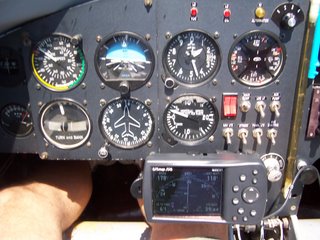On the Q-List there are lots of opinions about the need for a bigger rudder or fancy tail wheel and bracket. Some taildragger expert recently said something to the effect that "the plane needs a bigger rudder because the fuselage blanks out the vertical stab when the wheel is on the ground". Gee Whiz - I didn't know that. I guess I didn't know what I was missing.
I had to buzz down to Cape Girardeau yesterday and thought I'd try it out. On landing I tried using the tail wheel and rudder. Nope - nothing missing when I'm decelerating. I have full authority all the way down from touchdown 80 mph down to zero mph.
Alright, let's try a "slow" takeoff. I tried pushing the throttle in gradually, to see if there was a range where the rudder, tailwheel was ineffective. Nope again - full authority throughout the entire range.
So here's the deal, here's my humble opinions. Print this list out and paste it on your refrigerator door. Either that, or use it for TP.
1. The stock rudder does not need to be modified.
2. The stock tail wheel and bracket does just fine.
3. The stock tail spring needs to be beefed up. The stock ones break. (There are lots of ways to accomplish this fix. I have had very good results from Peter Harris's fiberglass spring).
4. You must align the wheel axles so if you peer through one, while the full weight of the plane is loaded, that you are aligned within a couple of inches of the opposite axle. If you build and align the wheel pants to plans, you will find when you sight through the axle that you will be looking at concrete instead of the other axle. This is bad. Seeing the other axle centered in the hole is good. Fix it, but don't get too anal about it, if you are within a couple of inches you should be a lot better off than you were. This is commonly referred to as the Gall Alignment. Do a search on it.
5. The Airheart go-cart brakes are plenty adequate, but the QAC mounts are crap. The LaRue brake mount is better, and the Coughlin mounts are better yet.
6. Differential brakes are a great mod. It took me 1,000 hours to admit it. Some guys use toe brakes - I use finger brakes. Six of one, 1/2 dozen of the other. I like the finger brakes because they are easy to access and maintain. Mine are mounted just aft of the throttle.
7. It's a very good thing to have a splitter in the rudder cables. That way, if the tail spring should break, you still have the rudder. Ditto the differential brakes.
8. I think the aftermarket intermediate rudder cable bellcrank is unnecessary.
9. The plane is FAST on the runway and requires your undivided attention to keep it on the centerline. This is not a Cessna 172.
Coughlin brake mount installed.
Coughlin Brake Mount
Rudder pedal splitter. One goes to the tail wheel and the one with the turnbuckle goes to the rudder horn.
Differential brakes and their respective master cylinders.










